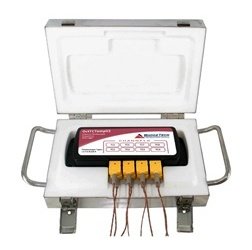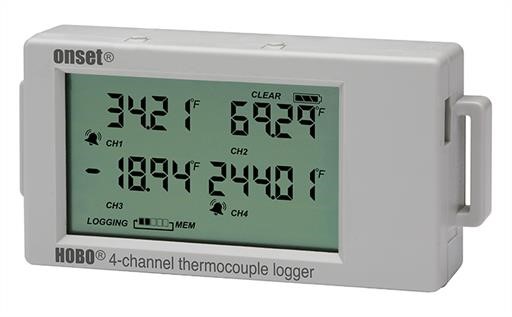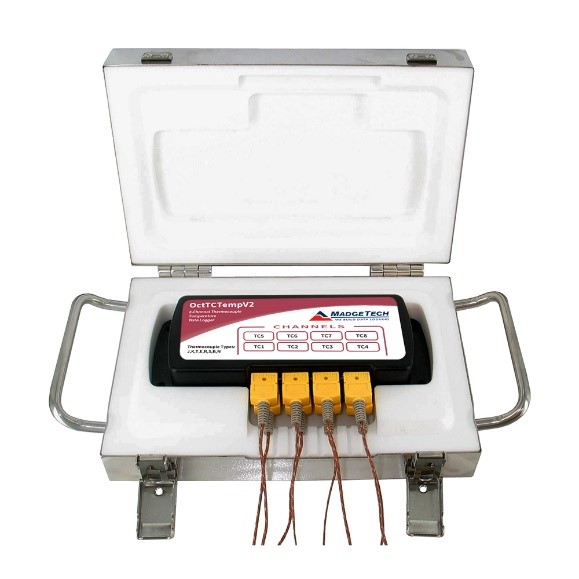How to use an oven temperature logger for temperature profiling

Oven temperature loggers are used in a range of applications from home and restaurant kitchens, to large scale food and non-food production facilities. When using an oven of any kind as part of a production and manufacturing procedure, it is critical to know that correct temperatures are being maintained to ensure the quality and safety of a product. An oven temperature logger will help you achieve this, as well as optimise production processes.
What is oven temperature profiling?
Oven temperature profiling or thermal profiling is the measurement of temperatures throughout an oven cavity. This information provides details as to what temperature was reached, at what point temperatures were reached, how hot the product became, and how for long.
How do you profile the temperature of an oven?
There are two main methods to profile the temperature of an oven depending on the type of oven used and the data required. These methods are stationary profiling or process profiling.
Stationary profiling is suited to a fixed oven. This method is where an oven temperature logger is placed either within the oven to collect data, or positioned externally with probes located inside the oven. These instruments are versatile, being suited for use in the home, as well as large scale food and non-food production.
Process Profiling is generally used within industrial tunnel or conveyer ovens where the product is moved through zones. To generate an accurate temperature profile you need to measure multiple zones within the oven to help ensure the desired temperature is being achieved throughout. This is done with multiple probes throughout the oven or, having an oven temperature logger go through the oven with the product.
Why profile the temperature of an oven
The quality of a finished product, whether it will be processed through an oven, kiln or furnace depends on the oven working correctly.
Benefits of profiling an oven include:
- Control Product Quality; Detect any variations in a process which may impact the quality of a product. Detect issues before they occur by having more statistical data on the inner workings of an oven.
- Process Control; Is the oven a critical control point? Or is heat treatment vital to the quality or safety of the product? An oven temperature data logger will provide reliable data to evidence whether processes are being performed in the same, repeatable manner.
- Process optimisation; Increase productivity using data analysis to find opportunities to decrease startup times and increase throughput.
- Save money; Streamlining of processes through process optimisation will minimise costs and maximise profits.
- Troubleshoot; Find oven faults quickly using collected data to undertake trend analysis.
Examples of oven temperature loggers available at Instrument Choice
Here are three oven temperature loggers that are representative of the range of devices supplied by Instrument Choice.
4 Channel Thermocouple Data Logger

Figure 1: Oven Temperature Logger. 4 Channel Thermocouple Data Logger.
Features
Perfect for mounting to the outside of stationary ovens, the HOBO 4 Channel thermocouple data logger makes temperature profiling easy.
Supplied with a built-in LCD screen for a quick view of real-time temperatures, logging status, battery use and memory consumption between data downloads. The data collection rate is easily customisable via the HOBOware software.
Thermocouples are sold separately. The HOBO 4 channel logger is compatible with types J, K, T, E, R, S, B and N. See Thermocouples for type specifications.
Applications
Stationary oven temperature profiling
Add-ins
On HOBOware easily view, graph and analyse collected data with ease. Connect the logger via USB and download the free software here.
4 Channel, Oven Temperature Logger with Probes
Product Code: QuadThermoVault
.jpg?Action=thumbnail&algorithm=fill_proportional&width=233) Figure 2: Oven Temperature Logger. 4 Channel Temperature Logger with Probes.
Figure 2: Oven Temperature Logger. 4 Channel Temperature Logger with Probes.
Features
The four-channel oven temperature logger with probes is built for oven extreme temperature monitoring and temperature profiling. Built to withstand the toughest conditions, the 4 Channel oven temperature logger can withstand temperatures up to 350°c for up to 25 minutes. Data collection rate can be easily customised on the MadgeTech software.
Built with an internal channel and four remote channels suitable for thermocouple types J, K, T, E, R, S, B and N depending on the required application. Kit includes a Type K thermocouple. See Thermocouples for type specifications.
Use
Suitable for use in both stationary and process profiling.
Add-ins
Data logger and software for the QuadThermoVault is sold here. Includes USB and full feature software connection for data processing and detailed report generation.
8 Channel Oven Temperature Logger
Product Code: OctThermoVault

Figure 3: Oven Temperature Logger. 8 Channel Temperature Logger with Probes.
Features
Perfect for oven temperature profiling the 8 channel oven temperature logger has eight remote channels for logging various temperatures within an oven. Adjust the logging rate, log oven temperature and easily upload via USB to the MadgeTech software to graph, trend and share data.
Built with an internal channel and eight remote channels suitable for thermocouple types J, K, T, E, R, S, B and N depending on the required application. Kit includes a Type K thermocouple. See Thermocouples for further type specifications.
Use
Suitable for use in both stationary and process profiling.
Add-ins
Data logger and software for the OctThermoVault sold here. Includes USB and full feature software connection for data processing and detailed report generation.
Thermocouples – What do all the letters mean!?
| Type | Overall Range | Use | Accuracy** |
| K (Chromel/ Alumel) | -260 to +1370 | The most common type of thermocouple used. ‘General purpose’ and used in a variety of applications due to its wide temperature range. | 2.2°c |
| J (Iron/Constantan) | -210°c to 760°c | Very common thermocouple type. Limited range compared to type K. | 2.2°c |
| T (Copper/ Constantan) | -260 to +400 | Generally, very stable with great accuracy. Used often in laboratory environments, food monitoring and freezers. | 1°c |
| E (Chromel / Constantan) | -260 to +980 | Non-magnetic, strong signal and accurate. Well suited to low-temperature use. E.g. cryogenics. | 1.7°c |
| R (Platinum/Rhodium) | -50 to +1760 | Suitable for high-temperature measurements. A similar composition to Type S however, has a slightly higher output and greater stability. | 1.5°c |
| S (Platinum/Rhodium) | -50 to +1760 | Suitable for high-temperature measurements. | 1.5°c |
| B (Platinum/Rhodium) | +60 to +1820 | Suitable for high-temperature measurements, the highest of all the thermocouples in this table. No output below 50°c. | 5°c (at 1000°c) |
| N (Nicrosil / Nisil) | -260 to +1300 | Very similar accuracy and temperature limits to the type K. Slightly more expensive than the K type. | 2.2°c |
**At 0°c unless otherwise indicated. See thermocouple manufacturers individual specifications for a precise indication of accuracy and range.
Conclusion
Temperature profiling of your oven, kiln or furnace is the ideal way to ensure product quality and safety is met while also maintaining process control and optimising processes. The goal is to save you both time and money!
Irrespective of your oven type or the way you would like to collect and analyse your data, the Instrument Choice online storehas an oven temperature logger available to meet your needs.
Need help selecting an oven temperature logger to suit your oven profiling needs? Unsure which thermocouple best suits your application? Contact one of our knowledgeable scientists on 1300 737 871 or [email protected].
Also interesting
Whether your environment is at work or at home, an indoor air quality monitor is an essential device if you’re serious about protecting the health, well-being and productivity of family members or work colleagues. Here are all the reasons why!

Soil pH meters are devices used by home gardeners and agricultural professionals to measure the acidity or alkalinity of a soil. Getting your soil pH right is a must if you want to produce healthy, vibrant plants. To get accurate measurements you need to know the right procedure for your soil pH meter.

